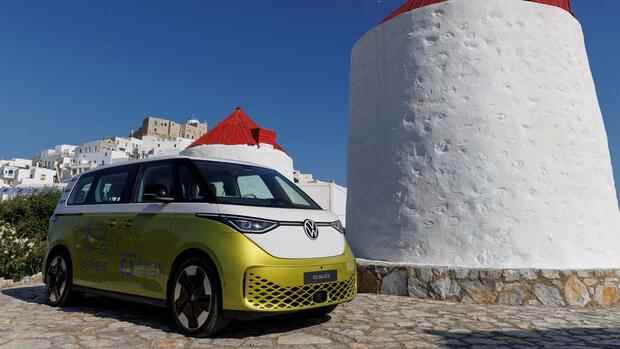Residents and tourists can use an app on the island to flexibly book trips with the new ridesharing service Astybus.
(Photo: Reuters)
Astypalea Sailing yachts and fishing boats bob in the picturesque harbor, around which whitewashed cube houses are grouped like rows in an amphitheater. A Venetian fortress towers over everything. An idyllic tranquility reigns on the Greek island of Astypalea. The 1300 locals are almost among themselves, only a few visitors stroll through the streets. The small island, which belongs to the group of islands in the Dodecanese around Rhodes, is off the beaten track with tourists.
But now Astypalea, previously only known to Hellas fans, is making a name for itself throughout Europe as a “smart and sustainable island”. The Greek government and the Volkswagen Group are testing concepts for holistic, climate-neutral electromobility here.
These include solar systems for generating green electricity, electric vehicles, car sharing and intelligent public transport services. By 2026, the island is to be gradually converted to smart, sustainable mobility and the energy system is to be completely renewed – a model test in fast motion.
The project is scheduled for six years. One year after the start in June 2021, the Greek Prime Minister Kyriakos Mitsotakis and VW CEO Herbert Diess have now taken stock of Astypalea. Mitsotakis underlined his country’s claim to play a leading role in the fight against climate change. With the project on Astypalea, “Today we are at the forefront of innovation in the deployment of intelligent mobility systems,” said Mitsotakis.
Top jobs of the day
Find the best jobs now and
be notified by email.
Greece has ambitious climate goals: by 2028 it wants to take all coal-fired power plants off the grid. VW boss Diess sees his company as a “driver of change away from gas, oil and coal towards renewable energies”. The project on Astypalea shows “that a rapid transformation to green mobility and energy is feasible if companies and governments work hand in hand”.
Mobility on demand replaces traditional bus lines
After the first fully electric vehicles arrived on the island a year ago, the second phase is now about the introduction of intelligent mobility services. They replace the traditional bus line, which previously connected only a few places on the 96 square kilometer island. The island’s residents and tourists can use an app to book trips with the new ride-sharing service Astybus.
The minibuses also drive to remote places on the island as required. Five vehicles from the Volkswagen ID.Buzz, which will be launched in autumn of this year, will be used. Rental cars, electric scooters and e-bikes can also be booked via mobile phone via the app.
Private car owners receive state subsidies of up to 40 percent of the purchase price and scrapping premiums for their old combustion engines for switching to electric vehicles on Astypalea. At the same time, a comprehensive network of public charging stations will be created.
“The concept is very exciting for residents and tourists alike,” said VW boss Diess to the Handelsblatt. Diess predicts that car sharing will reduce the number of vehicles on the island by a third from currently around 500 cars and 1,000 two-wheelers.
The VW boss not only wants to test new mobility concepts on the island.
(Photo: Bloomberg)
Ten percent of the vehicles are already electric, including the first VW ID.4 e-taxi. “We are experiencing the transformation of mobility in fast motion on Astypalea – here you can guess what mobility in Europe will look like in a few years’ time,” says Diess.
The project is accompanied by studies by scientists from the Aegean and the Scottish University of Strathclyde. The main issue here is acceptance among the local population. 65 percent of those surveyed are basically willing to switch to an electric car. The main obstacles mentioned are the acquisition costs and the lack of charging options.
At least 50 percent of the population said they were willing, under certain conditions, to give up their own car and only use mobility services. “We’re learning a lot on Astypalea,” says Diess: “It’s nice to see how the project is growing and how people are willing to change their behavior.” because it can now be experienced,” says Diess.
Not only the population learns new things, industry and politics also gain important experience. VW is currently looking at the extent to which electric cars can be integrated into the power grid. “The so-called vehicle-to-grid will be a big topic,” said Diess in an interview with the Handelsblatt. “In the future, as a mobile power bank, the car can help to balance out the volatile generation of green electricity,” explains the VW boss. “We’re about to bring this technology into our cars on a large scale, and Astypalea lends itself as a testing ground.”
80 percent of electricity from renewable sources by 2026
The island still gets most of its electricity from a diesel power plant that produces 4,800 tons of CO2 per year. Next year, the conversion of Astypalea’s energy system to locally generated green electricity from solar cells and wind generators will begin. The projects are now being advertised.
A large solar park is to be built by 2023, which will supply around three megawatts of green electricity. This will then cover 100 percent of the energy needs for e-mobility and more than 50 percent of the general energy needs of the island. This saves 800 tons of diesel fuel for the local power station. This reduces energy costs by 22 percent. By 2026, 80 percent of the electricity consumed in Astypalea should come from the sun and wind. The aim is to reduce the island’s CO2 emissions by 70 percent by then.
More: No future for combustion engines: ZF is converting its largest transmission plant to electromobility.
